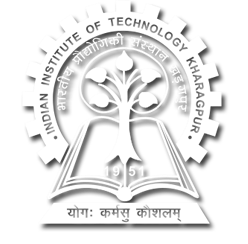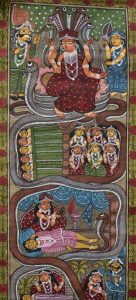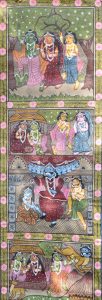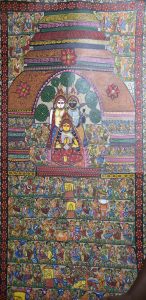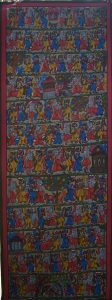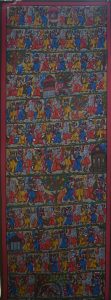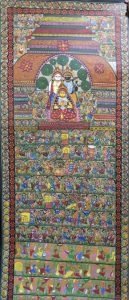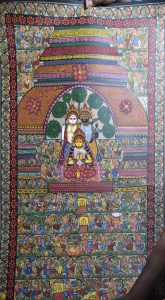Transcript
Chandan Chitrakar: My name is Chandan Chitrakar.
Interviewer: How many memebers are there in your family?
Chandan Chitrakar. There are four of us in our family.
Interviewer: Who is the eldest member in the family?
Chandan Chitrakar. My father is the eldest.
Interviewer: Is he still alive?
Chandan Chitrakar. Yes, he is alive.
Interviewer: How long ago did he settle down here?
Chandan Chitrakar. He has been living here for a very long time.
My parents came and settled down here even before I was born.
Before coming here, they used to live in Chaitanyapur.
As my mother’s parents were already settled here, my father stayed on.
He used to make clay idols before he took up this profession.
Interviewer: For how long have chitrakars or pata artists been living here?
Chandan Chitrakar. Since my early childhood, I have seen them living here.
Putul Chitrakar: Older people can tell you more about this.
We have heard that the pata art has existed for approximately 300 years.
Chandan Chitrakar. Earlier, patuas would constantly move from one place to the other.
They used to make makeshift shelters wherever they briefly stopped over for the short duration
and paint the scenes surrounding the villages.
Interviewer: How long have they been at Naya?
Chandan Chitrakar. For the last hundred years, as I have come to know from the elder members of the community.
Interviewer: Is there any connection between the pata artists of Purba. Medinipur and the ones here?
Chandan Chitrakar. Yes. They are very close to us.
They are all our relatives.
Some of their relatives live here and, similarly, some of us have settled down there.
We also perform programmes together whenever we meet at fairs or exhibitions.
The government invites people from both the areas to the programmes.
Sometimes, programmes/exhibitions are held in schools.
Interviewer: Which is the older settlement –the patua community from. Purba Medinipur or the one from Paschim Medinipur?
Putul Chitrakar: People of this area have been there longer.
Those in the east were not doing pata paintings in particular.
But here all are engaged in pata making.
In the east, very few practice it.
Only eight to ten households.
They do various other jobs, some ply vans.
Interviewer: Have those people moved from here to start work there?
Chandan Chitrakar: Over there, only a few serious ones were doing pata and wandering about villages.
The artist Raja Ali Chitrakar,
He is no more.
who was very renowned, was from there.
His songs were very lyrical.
He used to write the songs himself, but yes, he is no more.
His son and all other members of his family were engaged in this art.
Interviewer: Who is the oldest among the Chitrakars here in Naya? Who started it first?
Chandan Chitrakar: Dukhushyam Chitrakar is the eldest here.
I knew another artist, who is no more –
a very good artist named Pulin Chitrakar-
I had seen him while he was around.
His work both in painting and song composition – were very good.
Gouri Chitrakar, who was a President awardee, expired a year and a half ago.
Interviewer: What were usually the themes on which your father and other senior members painted on?
Chandan Chitrakar. Earlier, patuas didn’t compose these small square patas.
They used to make long scrolls, as they would wander around villages with the scrolls and sing.
Earlier the pata was never made for the purpose of selling.
Only when patuas started travelling to Kolkata after being invited by the government, customers requested them
for smaller patas that could be hung on the wall.
Such large scrolls were inconvenient because of the low heights of modern buildings’ walls.
From that time onwards, they introduced smaller sizes depicting episodes in parts.
Different sizes are made now; for example, similar to the. Kalighat painting; now paintings on Santhals,
narrating the fishes’ marriage are composed, which are very attractive especially for the Bengali people.
Interviewer: Is there any difference between the recent pata paintings and those of fifteen years ago?
Chandan Chitrakar. Yes, there is a difference.
Earlier, long scrolls used to be made by joining 10-12 papers in a sequence extending to a length of 15-20 feet
which were accompanied by pata songs.
But now times have changed.
Artists now depend mainly on sales, the demand of the market.
The volume of the demand depends on the quality of the artists.
Now we depict pata art on cups, plates, t-shirts, dupattas and other objects.
Actually, we were trained in this by. Banglanatak.com, an NGO.
They advised us to bring a change by painting on blouse pieces, kurtis, umbrellas, dupattas, stoles, which tend to sell more.
We found that the sales boomed.
In addition, we get work during the Durga Puja.
I am now doing one such painting for the Durga Puja festival, commissioned by Durgapur, which I am doing sitting here at home.
I have brought the plywood sheets for the purpose.
The work is almost nearing completion and the patas are stored on the upper floor.
We hope that we will get more work on the occasion of Durga. Puja.
During the rainy season, if we are able to get work, it is a big help to our families .
Interviewer: Do you feel any difference in the financial status of the present and the previous generations?
Chandan Chitrakar. Now the difference is between hell and heaven.
Now things are much better.
In the earlier days, as my elders have told me, we hardly used to get visitors from cities.
But now visitors come to our area on almost all Fridays, Saturdays and Sundays,
especially on Saturdays and Sundays and on public holidays.
Most of the time, they buy some items whether from me or someone else.
Interviewer: Which pata or scrolls attract customers? Is it the traditional mythological or the social contemporary ones?
Chandan Chitrakar. I generally make mythological patas based on a number of deities, which are mostly square.
There is demand for those, still.
Customers prefer to buy something with fine motifs and finish, something exceptional
but beautiful and suited for indoor decoration.
They always want something new.
Something new and eye-catching to be kept at home.
A good example of this is a painted tea kettle, which was not done earlier;
similarly, 28″ large copper plates that were not painted are now being painted with decorative patachitra.
They are selling well.
Copper bottles – all of which are very new in the market now – are in more demand.
All are new items.
Interviewer: Do customers no longer prefer long scrolls?
Chandan Chitrakar: No, they don’t.
Customers, visiting our stalls, would ask us, “Don’t you make smaller ones as buildings nowadays
are not very high, usually of 8 feet? So, leaving a margin of a foot on both the top and bottom of the wall,
the patas, maximum 5-6 feet in length, are the most convenient as hangings. Those would sell better.”
Hence, I usually make smaller ones.
Interviewer: What is the price difference between the smaller and larger scrolls?
Chandan Chitrakar: There is a huge difference.
Making long scrolls requires between a month to a month and a half or even two months on an average and their price
is around 15-20 thousand rupees.
I usually make smaller ones which take 8 days to make, are priced at rupees 2500, and get me many buyers.
Interviewer: Is the price determined by the labour that the artist needs to put in?
Chandan Chitrakar: We usually get a higher price from visitors from overseas.
The same pata that I can sell here, within the country, maximum for five thousand rupees,
I can sell for ten thousand rupees to a foreigner.
If outsiders come here, we are very happy.
If they find a pata attractive, they never bargain with us.
They pay a handsome amount, considering it to be a fair price.
They are able to understand the emotional investment of an artist in making a beautiful pata and do not mind paying.
Interviewer: Now, tell us about the songs.
Can you tell us whether any changes have occurred in the tunes or lyrics in the present songs from those of the past –
those of your father’s time?
Chandan Chitrakar: There is no difference.
The songs have remained the same as they were in the time of the earlier generations.
But now musical instruments like the harmonium are more popular as accompaniments.
In the earlier days, one would sing it solo.
Now when we are invited to a programme, we usually form a group of 4-5 or even more members.
We have 12 such groups in the village including a group in which 8-10 persons sing together.
Whenever there is a programme somewhere, these groups get invited to perform.
Earlier, it was not like this.
But the songs are almost the same.
In the mythological pata, the songs haven’t changed much but some changes can be observed in social narratives.
Like in the patas on bin Laden, tsunami, which are contemporary issues, the songs are obviously new.
Interviewer: How about the lyrics?
Have they stayed the same over the years?
Chandan Chitrakar: No, a little change can be seen in the language.
Here, little kids also paint.
Interviewer: Do you involve your children in the pata painting?
Chandan Chitrakar: Speaking about my family, I try to teach my children to do so.
My son and daughter go to school.
My son is in class seven while daughter is in class ten.
After school hours, they also engage in drawing pata.
Interviewer: What is your plan? Would they also engage in pata painting?
Chandan Chitrakar: In fact, education is needed in this profession for understanding English,
especially for communicating through email, in order to be able to work online.
Since, we are not educated, we often face difficulties in this.
Now, most of the communication takes place through the internet.
Education will help us in selling our products online and this is the reason children are being sent to school.
That is my reason for educating them.
Interviewer: As the children are getting educated, they might opt for a different occupation in future other than patachitra.
How would you feel about that?
Chandan Chitrakar: Yes, I would feel very sad.
Since I learnt it in my childhood by observing my parents, I know how difficult it is to learn the art of drawing.
I know it from my own experience.
So, if I were to tell them repeatedly that, “See, I have endured so much pain but God has changed our life.
Now this art is popular worldwide, so if you leave the profession, it will definitely be very unfortunate.
I will be really hurt.” I’ll never want my son to take up any profession other than painting.
I will never want my son to work under someone else.
Interviewer: Up to which class do children continue to go to school?
Chandan Chitrakar: Some make it to college.
One of them is studying in the Art College in Kolkata.
Ranjit Chitrakar’s son is studying in Government Art College.
My brother also studied up to college and afterwards involved himself in pata painting.
Interviewer: Would you please tell us about your religion? You all are. Muslims, but everyone bears the names of Hindus.
Chandan Chitrakar: I don’t have any idea or explanation about this really.
I have never paid any attention to this aspect.
My name is Chandan.
Similarly, all my brothers also have Hindu names.
We paint on Hindu deities.
But since my childhood I have been brought up in the Islamic religion.
Many people in Kolkata have also asked me that, your names are like those of Hindus, you are doing paintings on Hindu mythology.
I tell them, “Please don’t ask me.”
I don’t really know.
I asked my parents as well.
It may be, as I have heard from my parents, that we cannot sell the patas to Muslims.
We sell them to Hindus because other than Hindus, no one else would buy the patas on deities.
Muslims never keep pictures.
That is the tradition.
Many people here bear Muslim names.
There are many patuas who have two names – one Muslim name and another Hindu name.
But we have only Hindu names.
My father also told me that back in those times, almost everyone had Hindu names.
It is only recently that children are being given Muslim names.
Interviewer: To what extent do you people maintain Islamic rituals?
Chandan Chitrakar: Everything depends on the time.
During the month of Ramzan, we keep the Rozas;
Two Eid festivals are celebrated in a year – Ramzan Eid and. Bakr-Eid.
Eid would be celebrated just after two days.. This time it is on Wednesday.
Each Friday we perform the namaz.
When we go out to work, it sometimes becomes difficult to do so.
But if there is time, we visit the mosque and perform the namaaz.
Interviewer: If circumstances arise which may force you all to become puritan Muslims, to what extent would you accept that?
Would you abandon your profession?
Chandan Chitrakar: I can’t quit.
As I have been involved with it since my childhood, if someone comes and tells me to stop doing it –
no one can interfere in my profession which will otherwise become extinct.
As I have been involved with it since my childhood,
If someone comes and asks me to quit patachitra and become a puritan Muslim, I won’t comply.
I cannot abandon it in the name of religion.
If someone tries pressurising me, I’ll obviously take necessary legal steps.
Interviewer: When the patas are sent to exhibitions the artist is going to participate in, do they bear the name of the artist
or that of the organisation.
Does it say that the patas that are sent are from Naya, or does it carry the artist’s name too?
Chandan Chitrakar: No pata is sent in the name of the artist if it is sent through an NGO.
It is only stated that the artists are from Naya and the pata is by different chitrakars.
But the names of the chitrakars are mentioned if it is organised by the Government.
Out of the 80-85 artists who live here, ten artists might be selected to participate.
It is in fact advertised in the name of these artists.
Interviewer: Do you feel that the artist’s name is sufficiently brought into the limelight?
Chandan Chitrakar: It depends on the artist’s creation.
Every year a competition is held amongst chitrakars from which the best of the talent is selected.
It is largely organised by the Handicrafts Department.
After the Vishwakarma Puja, this competition is held.
Suppose I am awarded the 1st or the 2nd prize, the. Government would give me an award and list my name.
There are remarkable incidents like the tsunami or other natural calamities or social events
on which patas have been made and have also gained much appreciation from all over the world.
Do you highlight the name of the artist who first drew the pata that all others began to draw subsequently?
Or is the entire village credited as a whole?
Chandan Chitrakar: No.
Not everyone composes pata.
However, here, Dukhushyam, who is the pioneer, creates it first with a new idea and composes a song on the same.
He promptly composes the images along with the lyrics on any incident or event he comes across on TV or in the papers.
Whenever there is a training seminar of the artists here, The ‘office’ takes the initiative to tell him, “Master, Dukhushyam Babu, you train 20 people here” and he does that.
When my wife attends his class, she learns the song and then starts making the pata while singing along to it.
Through her, I, too, come to know of the story and draw the same.
(mosque prayer call interruption).
This time I worked there – when Vasudev Babu called, the work was at a gallery of Rabindra Sadan…
The renowned Bengali actor Mr. Prasenjit Chatterjee had seen my work a week back in the gallery and had asked
the organisers to introduce him to the artist.
He bought one of my paintings displayed in the gallery.. He has liked that one on a visit about ten days back.
So, I was called forth.
He had asked for me as he wanted me to make an artwork for him.
I just finished it according to his requirements and gave it to him just a few days back.
I have a picture in my phone,. I can show you that pata.
It was on rural Bengal.
Did you take other patuas along with you?
Chandan Chitrakar: Yes, seven to eight chitrakars went along.
They were also there when we were called by the government for some work.
Are these seven to eight patuas part of your team? Do you work together?
Chandan Chitrakar: Yes, we usually work together.
When I leave for the Durga Puja pandal decoration, I am accompanied by these patuas.
Interviewer: Are the names of all the artists in your team mentioned there? Or does your name get highlighted?
Chandan Chitrakar: No, the entire team is acknowledged.
The names of all of our team members are mentioned.
However, I have been assigned the responsibility amongst all as it cannot be given to all.
I usually work with Mr. Anirban Das who is an extremely talented artist himself and is also attached
to the Jago Bangla stall.
He often calls me asking me to bring other artists to work there.
We go, work and get our due payments, the other patuas are also aware of how it functions.
Interviewer: How did patachitra begin? Have you heard of any story from your elders regarding the origin of the patuas?
Chandan Chitrakar: As I have heard, patachitrakars, like Bauls who sometimes live here and sometimes there, were also living the same way.
Say about four families were living here in Naya while four others were living in the Collegedanga area;
yet four others were living in Chaitanyapur of Sutahata; they were all scattered.
No one lived together with their families.
When they travelled to someone’s house, if the house owners were pleased with their performance, they would be allowed
to stay there for some time.
They would usually make makeshift shelters and would return here after 2-3 months bringing some cash.
and stay on for a few days before travelling to the same destination; as far as my understanding of the past goes.
Now, they have all made their own houses here and live here with their families,
work from here and also go to participate in various fairs and exhibitions.
Interviewer: Are you aware who made the first mythological pata?
Chandan Chitrakar: An artist named Pulin Chitrakar who expired…
I have seen his old works and probably his sons have sold them already.
It is almost eight or nine years since he passed away.
Interviewer: What was his age?
Chandan Chitrakar: He was old, probably about 85-86 years old.
(camera dies). This happened 8-9 years back.
I heard from him that this art was almost 300 years old.
He said he had learnt it from his grandfather.
I have a distinct memory of being told this by him at a very young age.
He could never travel to Kolkata.
He must have known when and where it first started.
He used to work here sitting at home.
Customers used to come to his place.
Now an elderly person, Dukhushyam Chitrakar, is around.
He must have more knowledge about this as the age difference between the two of them was 15-16 years.
I am about to sing a song on the abduction of Sita.
My name is Putul Chitrakar.
The wedding was over
Ramchandra crossed the river
To keep his father’s promise
Goes into exile.
Ramchandra led,
Janaki followed
The archer Lakshman followed them both
The sun was blazing hot
And the sand below was hot too.
Sita was weak
could not walk any further.
Breaking the branch of a tree
Lakshman placed it on his head.
Asked Lakshmi to walk slowly slowly
under its shade.
The two brothers made a hut out of leaves
Rama and Sita were playing a game of dice.
Lakshman was standing as guard.
Surpanakha came in search of flowers
Lakshman held her nose and cut it off.
Surpanakha went back to Lanka with her nose
and threw herself at her brother Ravana’s feet.
The clever king Ravana
came up with a wise plan
Seeing his sister’s state, furious with anger.
He called Marich and outlined his plan.
Said, “Marich, go to the Panchavati forest
where Rama, Lakshman and Sita are staying,
While Rama goes away to kill you
You should call out, “Dearest brother Lakshman”
These few words Ravana taught Marich.
Marich then changed his form into a deer.
Oh! what a splendid sight it was
to see the deer dancing in a beautiful rhythm.
Seeing this, Chandramukhi (Sita) calledRaghuvara (Rama)
Holding the dice humbly, requested Chandramukhi
“Catch that deer and make me happy.
We two will play dice
Sitting in the forest
We will overcome sorrows and joys,
Looking at the deer.”
“Listen Lakshman, I’m going to catch the deer to fulfil. Sita’s request
Untill I come back to the hut
You keep a watch on Sita.”
Rama chased after the deer into the forest.. The golden deer Marich fled fast and disappeared.
At a little distance, Ramchandra killed Marich.
Marich, in disguise, started crying loudly.
Sita heard the voice of Marich
repeatedly calling out to Lakshman.
“Lakshman, come —
go and search for your brother.”
“Brother has asked me to keep watch on you
Now, you are telling me to go out, why?”
“Lakshman I clearly understand your intentions.
If my husband dies, you would be Janaki’s companion.”
Shame, shame, Lakshman touched his ears.
“You are like my mother Sumitra.. Brother Rama is like my father.”
Lakshman drew a boundary line around Sita and departed.
Ravana came out
from under the banyan tree.
“Give alms, give me alms, Mother
Please give me quickly so that I can move elsewhere.
”If he didn’t get alms, he said he would rather give up his life
Afraid of killing a man, Sita trembled in fear.
Sita crossed the boundary to give alms
Suddenly the king lifted her off and put her in his chariot.
The chariot started flying away.
Thus I have sung a song on the Ramayana.
This is to end the poem’s narration
My name is Putul Chitrakar
Paschim Medinipur is where I live.
Namaskar.
